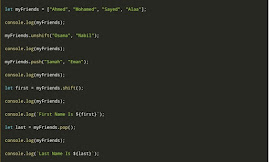
Hello This is the day 30 of #30 days of javascrip coding, at this day I studied Object Lesson and i learned that 1- Object t has properties or data and has specific actions that it performs with methods. 2-The Window and the Location types are Object, knowing that the Location is considered a Nested Object from the Window, which is also an Object. 3-After that, when I use the href with the Window.Location object, here it expresses the properties, and here I inquired about a property or data, which serves as a link to the site that I opened, it is information! 4- But if you are dealing with a Method that executes a specific Action, then why do we use assign with Window.location 5- Here in Action, it will happen that the site that I opened will change its address to the Google site and the Google site will open instead. Here in Action, it happened and it remains under the scope of the Method, and this i...














